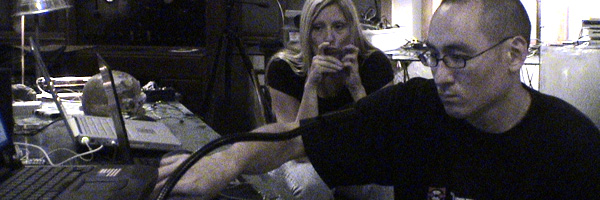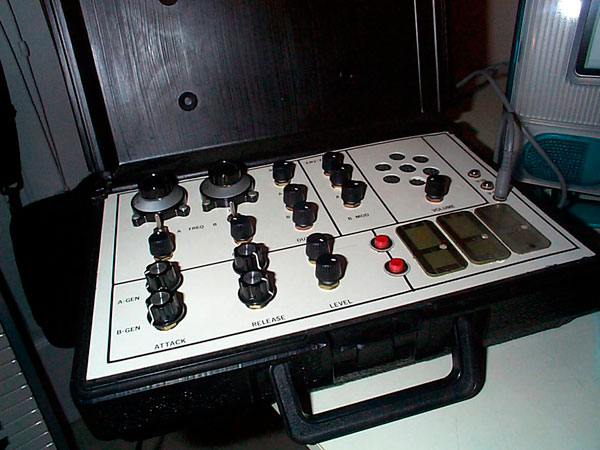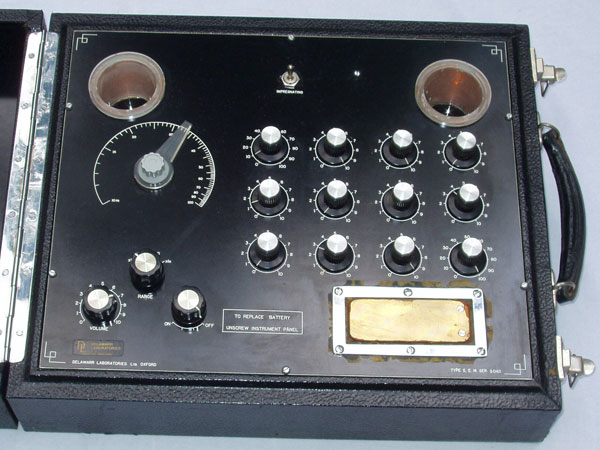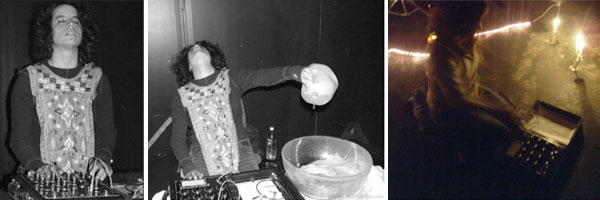The Spark Festival provided Todd Thille and I the opportunity to perform the first ever 'authentic' rock concert; that is to say, a concert where the rocks were making the tunes. For me, it was also my first 'public' performance as an electronic musician. But it wasn't until Thursday night when Todd, Steve Nalepa and I went to the Whole night club to hear Richard Devine be interviewed that the thoughts which present themselves here began to assemble.
I met Richard last summer for the first time when he came, at the invitation of Steve, to stay for a few days at the studio. We had exchanged a few emails, but I was not up to speed on his actual history or approach to sound. What immediately struck me when he began to narrate his learning process in the interview, was the extremely visceral and physically intense approach he had to sonic composition. Richard described his completely obsessive quest for the right instruments, and from them, the right sounds, which he hammered and wrestled into anti-compositions. He described his early work as a fusion of Punk and Hip Hop, to my ear a violent, consumptive rendering of sound that would make any junk yard demolition crew proud. To Richard's ear, the psychedelic impact of hearing a wad of paper being crunched into a ball while high on DMT is about as good a sonic experience as one could ever wish for.

Richard Devine - Dragonline Studio, July 2007
Last summer, I began to get a good sense of this inner demon of de-constructed sound down. He devoured every sonic tool we had, all to forging an alien sonic space. I hadn't at the time realized that he also designed his own equipment. Then, at one point in the Spark narrative, Richard flashed pictures the instruments in his home studio he had commissioned to be built, I sat up. Briefly, as images flicked by, I saw what I thought to be a Radionics device. Asking him about it later, he said it was the "Chaos Synth", a processor custom built for him by Tim Adams. What I took for radionic rubbing plates were indeed rubbing plates, but ones used to control volume and tone with the surface of a finger.

"Chaos Synth" (Image courtesy of Richard Devine)

de la Warr radionic device
At that moment, in my mind a very unusual series of correlations began between sonic art and radionics began.
Few people today believe radionics devices actually do anything. There is even a scathing display in the Minneapolis Science Museum section on Medical Quackery devoted to Dr. Albert Abrams, the founder of Radionics. The distain is mainly because the energy radionics devices purport to manipulate can not be authenticated by science. As I listened to Richard describe the process he has evolved for making his music, I also saw that the sounds he was searching for only became available as the technology evolved which enabled them to be synthesized. Their origin in Richard's psyche was also beyond authentication by science. Sure, the types of sounds probably could be heard in nature or conjured out of some mechanical thrashing, in the manner of Cage and Stockhausen, but without electrical stretching, processing and overlay, could these sounds effectively become functional components of sonic composition?
So, my thinking rambled, maybe the creation and design of radionics machines made the mysterious blend of chi and electronic energy usable for their inventors as well? Could not some subtle sense of design, like whatever drives Richard to find new sonic sources, also have guided these healer/inventors to appropriate energy directly from the core of Nature, calibrate it through dials, and direct it with intent through wires or light? Perhaps certain instruments have to be used by someone in a special way before everyone else knows what they can do; true enough in music, right? Could sonic based art forms exist without artists first manipulating new or unlikely tools, in such a way as to contort their original meaning and purpose into something never before heard? And then, in turning the process around, design new tools to find yet more sounds?
OK, you think, but sound is audible and can be scientifically measured; it's not some invisible 'energy' like we say the radionics box is directing. True enough, but while the sound can be measured, the 'art' component of a work cannot. The 'art' comes from the same type of invisible domain that the healer enters to reverse the process of a disease. Both artists and radionic healers apply their knowledge to instruments that are in the here and now, but they control them in ways that defy and transcend mechanistic analysis. If manipulating any measurable sound was enough for Richard, he wouldn't still be scouring the world for sound configurations that haven't been heard before. The 'art' component is the unmeasurable process that extracts new meaning from form. Sometimes in order to discover new meanings, old formal processes have to be overturned. To understand radionics, the scientific prejudice for discarding the role consciousness plays in any empirical inquiry or analytical activity must be re-considered. Radionics cannot be studied in a scientifically 'objective' manner because it is a self referential methodology like art. And like art, radionics is impossible to practice without first considering the role of the practioners consciousness in the activity.
So, if that is true, then what type of an art tool is a radionics device?
Well, watching Richard, Todd, or Steve or anyone else I have seen make electronic compositions with a computer, I would have to say the computer IS the radionic device. I am saying a radionic device is a tool that translates a non-material intent into an external environment or living system. In fact, most art making tools are radionic, pure and simple. But what does that mean?
When making art, the artist works against their own inertia. He or she also works against cultural inertia, the burden of all previous art and artistic assumptions. All our instincts to remain in relative comfort in a familiar artistic world is in fact submission to confinement within fixed cognitive boundaries. Breaking through these self-imposed boundaries reduces the inertia of culture and habit. We feel freer and happier the less inertia life imposes upon us. To attain freedom, we utilize tools and techniques we first discover in ourselves and then apply to our tools. I am a carver by profession. When I began carving I was all thumbs. Every time I hit the chisel, the next time I hit my knuckle or finger. My consciousness was trying to learn how to direct the chisel into the stone to manipulate the surface without hurting my hand. The pain on my blunders added to the inertial weight of learning the carving process. I needed to employ my consciousness to alleviate the inertia. The better I paid attention, the more I overcame the inertia, or unconsciousness, of being a novice carver. The hammer and chisel were the radionics device I employed to overcome inertia.
Of course I wasn't using a chisel to cure a disease the way a radionics device appears to do, unless you allow ignorance as a disease. I was using the chisel to train my mind to embrace a state of neg-entropy in my work process, making the work move faster and better, with more control. As I sat and listened to Richard, I heard him describe finding and utilizing numerous sound technologies for much the same purpose. The sound being produced wasn't the point; it was the degree to which the process of creating the sounds produced that feeling of ascension; i.e, the neg-entropy. The composition was a by product of the ascension, but that is what was left to share.
That isn't all. As I carved, I naturally grew tired. Carving is a very physically exhausting task, compounded by the pain of striking ones hand with a heavy hammer. Yet there were many times that toward the end of any given day or night, just before I was about to collapse with fatigue, that suddenly everything changed. The exhaustion would dissipate; the hammer blows would begin to harmonically align, making carving graceful and easy. In short, my mind and body slipped into a state of neg-entropy, a state of sublime harmony that spontaneously arose at the end of the work cycle. No doubt most people have this experience in some way or another; it's very gratifying and hard to forget. I get the feeling artists in particular crave the experience; it certainly seemed familiar to Richard.
So, if by accident, working with simple tools in a creative way can precipitate this very pleasurable release from ones' ordinary constraints and foibles, what could happen if more sophisticated tools were developed that accelerated the process? Don't we agree that computers provide acceleration of this sort, especially when wedded to a creative process?

Performance artist Carly Ptak of Heresee using a de la Warr radionic device.
Electronic music is usually found in night clubs. VJ's, like Todd, expand the medium into light and space. Most performances are spontaneous, not extensively pre-conceived; the artists work through improvisation, interpreting and guiding the atmosphere of the club as it unfolds throughout the evening. An environment is generated that creates a communal neg-entropy; spirits are lifted, people move and dance, the worldly cares grow remote. These effects aren't accidental. The DJ's and VJ's have to use their tools to spring the energy. They have to put hand and mind to instrument and carefully guide the space into an enveloping sense of beauty.
So what does radionics have to do with this familiar occurrence? Think of radionics as something that works directly on inertia utilizing directed intent. If I can discover that a hammer and chisel can be used to dispel inertia and open my mind to pouring free flowing cosmic energy into my work, why shouldn't I believe it is possible to use a calibrated instrument composed of dials and rubbing plates to extend that energy into specific parts of my body or my art, or for that matter, the environment?
What happens to a sound signal when you tweak it with all the effects in your software? It radically changes its nature. You can guide the sound design with a very intuitive part of your being. You then mould it into fixed, pre-determined parameters. Why shouldn't we believe we can refine ourselves the same way, by removing the inertia that holds us down? Why not have at our disposal instruments that reduce inertia—ones of dials & chips & wire, programmed to focus neg-entropy on our own blocked circuits?
Who says we can't utilize consciousness in technology to help us overcome the inertial barriers we may confront? Doesn't music sooth the savage beast and TV the savage child? Could not our predecessors working at the dawn of electrical instrumentation have accidentally invented a methodology for accessing neg-entropy, back in the days when nobody really understood electro-magnetism very well? Couldn't they have done it just because they decided they could? Look at all the other wonderful things they discovered then? How can we be so absolutely certain radionics devices don't work, when a hundred years later they are still being designed and used all across the world?
A hundred years ago who would have believed we could store a thousand symphonies on a microchip? Who would believe you could sit down with a slender typewriter like device and design and play the complex sonic architecture used everywhere in multi-media composition? Richard followed a sonic design process that began in the outside world with hitting keys on a piano as a child. He quickly morphed his consciousness into a labyrinth of sonic machines, electronic devices and finally today, advanced, multi-layered computer processing. At each stage he moved deeper and deeper into the invisible landscape of coded information, searching all the while for an elusive sonic element. Is it so hard to imagine this journey won't eventually reach a symmetry break with the external world, and Richard will find himself entirely inside the matrix of his own consciousness, using radionic tools to fashion a music of the spheres?
Personal Radionics. Our effort to articulate and demonstrate a case for biological or Nature based intelligence through our experiments with plant and rock milli-voltages has elicited a not unexpectedly high degree of skepticism. What is hardest for well trained scientific minds and also for less well trained ordinary skeptics to accommodate is the idea of an all pervasive, numinous life energy that is filled with intelligence. We are used to experiencing energy in utilitarian forms such as power generation or communications, and in the familiar turbulence throughout nature. The hard nut to crack is the role emotion and feeling play (as energy) in bridging the divide between Human Intelligence and Nature Intelligence. Our capacity to feel allows us to get outside ourselves; thus, the role of art.
On the plane back from Minneapolis Todd and I were discussing the inertia-busting function of art, when the passenger to my left asked if I was a physicist. Hardly, I replied, just a submerging artist experimenting with sound. It so turned out our conversationalist was himself a Bach scholar and accomplished professional choirmaster ( Dr. Thomas Rossin of Exultate ). We couldn't resist the opportunity to play for him our plant recordings, and so the conversation began. While non-committal about what he heard from the plants, when the question arose about experiencing the inertia-busting characteristics of music, he had much to say.
I had asked whether in his choral experience he had ever experienced something like 'duende*' [tenure duende/ having soul]. Duende is the mysterious, dark force flamenco musicians speak of which arrives without warning, possessing and authenticating their art. In flamenco tradition, duende rarely makes an appearance during any public, commercial performance. It is mainly considered a private, sacred enchantment given only to the performances done purely for the sake of the art.
We have experienced the best aspects of bio-communication when it was entirely spontaneous and joyful, free of analytic probing and opportunistic demands. So, I was surprised when our traveling companion said that indeed, he had experienced in a public context that very experience of a powerful energy superimposing itself upon a performance, on two notable occasions. The first experience was the result of incrementally expanding emotional exuberance felt by the whole choir. Our companion said that at the peak, the energy literally pushed him off the podium. On the second occasion, the choir was singing in Poland in a small church following the liberation of that country from Soviet oppression. At the highest moment of public exhilaration, a small child was moved to walk alone down the aisle of the church and press her only doll into the hands of Dr. Rossin. This incomprehensible expression of selfless giving caused all in attendance to reach an extraordinary plateau of emotion and religious rapture, upon which our companion simultaneously experienced a state of transcendence.
So, what is this experience, this energy? We know it is often perceived in daily life as the product of a very emotionally charged situation. Consider for a moment that Nature Intelligence may be, may continually experience, such a totally Monist, unified, ego transcendent, purely immersive state of being, state of awareness at all times. Such an experience, when we allow it to touch our own individual lives, becomes a form of rapture. It blows away science, cognition, all duality. Is it only our investment in our individuality, with its fear of death, that filters such sustained contact with Nature? Do the subtle signals we think we hear coming from rocks and plants actually have more in common with love than with electricity?
"I have with me a whole treasure of learning, but where is the sigh of the morning and the tear of the early night?" Khwaja Hafiz
Duncan Laurie 3/7/08
-------------
"So, then, the duende is a force not a labour, a struggle not a thought. I heard an old maestro of the guitar say: ‘The duende is not in the throat: the duende surges up, inside, from the soles of the feet.’ Meaning, it’s not a question of skill, but of a style that’s truly alive: meaning, it’s in the veins: meaning, it’s of the most ancient culture of immediate creation.
"Everything that has black sounds in it, has duende." (ie emotional 'blackness').
"This ‘mysterious force that everyone feels and no philosopher has explained’ is, in sum, the spirit of the earth, the same duende that scorched Nietzsche’s heart as he searched for its outer form on the Rialto Bridge and in Bizet’s music, without finding it---"
"The arrival of the duende presupposes a radical change to all the old kinds of form, brings totally unknown and fresh sensations, with the qualities of a newly created rose, miraculous, generating an almost religious enthusiasm."
"All the arts are capable of duende, but where it naturally creates most space, as in music, dance and spoken poetry, the living flesh is needed to interpret them, since they have forms that are born and die, perpetually, and raise their contours above the precise present."
—García Lorca, Theory and Play of the Duende
